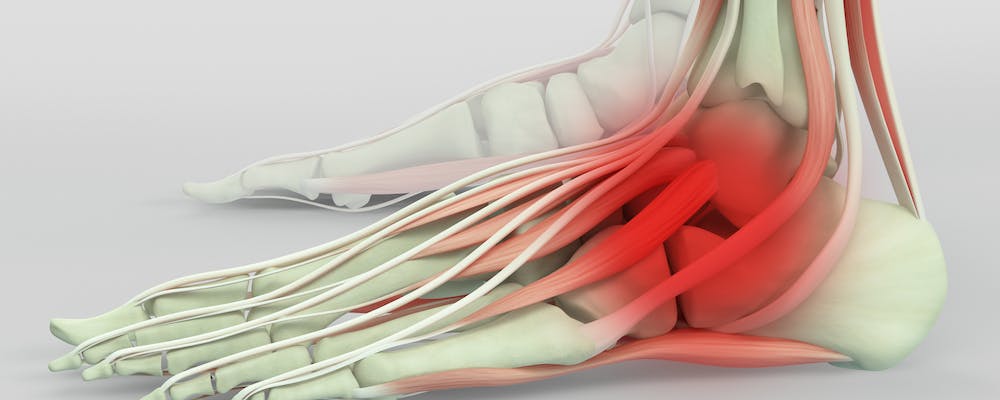Does your back hurt after a long walk or run? Are you prone to shin splints? Do you rely on supportive shoes and orthotics to get through the day? How you walk and run may be the problem. Be sure to read this blog to find out if mistakes in how you move are causing you pain. At Action Physiotherapy, we’ve helped many people correct their walking and running mechanics, to help them move about pain free.
The biggest problem that I see with most people in regards to their gait, is how they use their heels. If you look at your dog or cat, you’ll notice that their heels are half way up their leg, almost where our knees are. Why the difference? Since we only have 2 legs, stability and support when we are standing are much more important than for our 4-legged friends. That is the essential role that our heels provide: stability and support. Let’s look at what happens to our feet mechanically when we stand.
When we put weight and pressure on our heels, the arch of your foot relaxes and your toes naturally splay a little. This is the classic ‘flat foot’ position. Your feet want to cover a wide area to give you balance and stability. When weight goes through our toes, our arch stiffens and creates a high arch. This does 2 important things: First, it creates a strong lever for our muscles to act on, allowing us to propel ourselves forward when walking or running. Second, it absorbs and transfers force. When weight through our toes have created a stiff arch, our heels are still being driven towards the ground by gravity. What’s resisting that force is your calves. They have effectively become shock absorbers for your body. More on that in a bit.
Remember that flat feet and high arches are not bad things. Your feet need to be able to do both. It’s only when your feet lose the ability to transition between the two that problems arise. You can even demonstrate this effect yourself with your hands! Stand up and place a relaxed hand flat on a table. Lean on it and put your weight through the heel. Notice that your palm flattens and your fingers slightly spread. Now lift the heel of your hand slightly and put your weight through your finger tips. Your hand now creates a tight arch. Now that we understand a little more about how our feet work, let’s see how we can use this to our advantage.
When our bodies are in motion, there is always a balance or trade off between mobility and stability. Since our heels are responsible for stability, the faster we move, the less we want to heel-strike. When we are running or jogging, we should never be heel striking. In case that wasn’t clear:
NEVER HEEL-STRIKE WHEN YOU RUN! EVER! FOR ANY REASON!
If you take nothing else out of this blog, please remember that. Not only are you less efficient if you heel strike while running, you are actually hurting yourself while you do. Let’s look at those two points in greater detail.
First let’s talk about efficiency. We know now what our feet want to do when there’s weight through your heel; they want to spread and flatten to provide stability. So, if we heel strike while running, our arch is ‘loose’ and the front part of our foot almost slaps the ground. This almost acts as a small brake pedal being applied to every stride. Then to propel ourselves forward, all of the muscles in your foot need to re-engage and tighten up to create a fixed arch so we can push off the ground. Your body needs to exert more energy to re-engage these muscles and to overcome the small amount of momentum that was lost. While the amount of energy is small, when you think of that amount applying to every stride over 5 or 10 Km, it doesn’t seem so small anymore.
Now when we strike with the balls of our feet, things change drastically. First, our arch remains fixed. This maintains an efficient lever for force transfer for the duration of the stride. Next we load our calf muscle to prevent our body weight from driving our heel into the ground. Since muscles are elastic in nature, this actually stores kinetic energy during the load that we can use to propel ourselves forward. This dramatically increases the mechanical efficiency of our stride when running.
One side note here: The degree to which you toe strike is very dependent on how fast you’re running. When we’re sprinting, the toes and balls of our feet are the only thing that will be touching the ground, as our momentum will keep our bodies quite still in the air. However, the slower we run, the closer we want to strike the ground towards the mid foot to minimize ‘bouncing’. This will take some time to get a feel for, but just make sure you aren’t striking with your heel first.
ABSORPTION OF FORCE
The other big advantage of not heel striking is the absorption of force. Earlier, we talked about how our calves act as shock absorbers when we strike with the balls of our feet. Most people are not aware of how important of a function this is, due to our shoes. If you try jogging barefoot, you’ll discover it’s importance very quickly, especially if you’re on asphalt or concrete. The shock of each impact is driven straight up your legs to your hips and your back causing damage with each stride.
Running shoe advertisements always focus on how well they absorb force and cushion our heels when we run. Unfortunately all that does is promote poor running mechanics. If you’ve ever seen a distance running event on TV, you’ll notice all of the top runners have very minimal shoes with very thin soles. With that type of footwear, it’s impossible to run the amount they do with poor heel striking mechanics. If you’ve ever seen the osteopath in our office, you’ll notice that he wears toe shoes for everyday use to help promote good foot mechanics. This brings us back to walking mechanics.
If you’ve ever heard someone with a really heavy step stomping around, this is someone with poor walking mechanics. Just like with running, if we stomp with our heels when we walk, that creates shock waves up the legs that can harm our hips and back. A gentle heel strike while walking is not a bad thing at all, and is often preferred as we need more stability in our feet walking than we do while running.
AVOID LONG STRIDES
The biggest issue I tend to notice is where people’s centre of gravity is in relation to they’re feet. Most people tend to take a long stride forward, then pull their body toward their feet. The heel becomes the anchor for that pull, and leads to much heavier impact on the ground. If you watch people walk barefoot, or watch old videos from the first half of the last century, people’s strides were much shorter. This is due to them not having footwear to absorb force driven into their heels. Their strides were shorter, but tended to have a longer follow through. Their centre of gravity was much further forward in their stride, allowing them to strike gently with their feet.
As you can see heel striking and foot mechanics are a deep and complex issue. Hopefully you’ve learned some useful information, but if you’d like an in depth analysis of your gait, click HERE to book an appointment with one of our professionals or give us a call at 905-457-7475 , and let us help you.
We are here to help
 Robert Kappes, Registered Physiotherapist
Robert Kappes, Registered Physiotherapist
Click HERE to view our video on this topic on Facebook
- Blog Post written by Paul McCrimmon (Osteopath)

